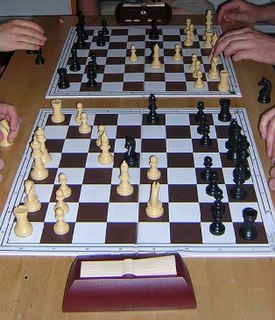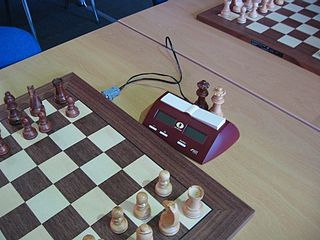Castling is a move in chess. It consists of moving one’s king two squares toward a rook on the same rank and then moving the rook to the square that the king passed over. Castling is permitted only if neither the king nor the rook has previously moved; the squares between the king and the rook are vacant; and the king does not leave, cross over, or end up on a square attacked by an opposing piece. Castling is the only move in chess in which two pieces are moved at once.
A chess opening or simply an opening is the initial stage of a chess game. It usually consists of established theory; the other phases are the middlegame and the endgame. Many opening sequences have standard names such as the "Sicilian Defense". The Oxford Companion to Chess lists 1,327 named openings and variants, and there are many others with varying degrees of common usage.

Bughouse chess, tandem chess, transfer chess, double bughouse, cross chess, swap chess or simply bughouse, bugsy, or bug) is a popular chess variant played on two chessboards by four players in teams of two. Normal chess rules apply, except that captured pieces on one board are passed on to the teammate on the other board, who then has the option of putting these pieces on their board.
This glossary of chess explains commonly used terms in chess, in alphabetical order. Some of these terms have their own pages, like fork and pin. For a list of unorthodox chess pieces, see Fairy chess piece; for a list of terms specific to chess problems, see Glossary of chess problems; for a list of named opening lines, see List of chess openings; for a list of chess-related games, see List of chess variants.
The French Defence is a chess opening characterised by the moves:
The King's Gambit is a chess opening that begins with the moves:
The Sicilian Defence is a chess opening that begins with the following moves:
The Dutch Defence is a chess opening characterised by the moves:
In chess, the fianchetto is a pattern of development wherein a bishop is developed to the second rank of the adjacent b- or g-file, the knight pawn having been moved one or two squares forward.
The Najdorf Variation of the Sicilian Defence is one of the most popular, reputable and deeply studied of all chess openings. Modern Chess Openings calls it the "Cadillac" or "Rolls Royce" of chess openings. The opening is named after the Polish-Argentine grandmaster Miguel Najdorf, although he was not the first strong player to play the variation. Many players have relied on the Najdorf.
The Alekhine's Defence is a chess opening that begins with the moves:
The Réti Opening is a hypermodern chess opening whose "traditional" or "classic method" begins with the moves:
The Bishop's Opening is a chess opening that begins with the moves:
Queen's Pawn Game broadly refers to any chess opening starting with the move 1.d4, which is the second most popular opening move after 1.e4.
The King's Pawn Game is any chess opening starting with the move:
The Zukertort Opening is a chess opening named after Johannes Zukertort that begins with the move:

In chess, promotion is the replacement of a pawn with a new queen, rook, bishop, or knight of the same color. It occurs immediately when the pawn moves to its last rank, with the player choosing the piece of promotion. The new piece does not have to be a previously captured piece. Promotion is mandatory; the pawn cannot remain as a pawn.
In chess, the Dragon Variation is one of the main lines of the Sicilian Defence and begins with the moves:
In a game of chess, the pawn structure is the configuration of pawns on the chessboard. Because pawns are the least mobile of the chess pieces, the pawn structure is relatively static and thus plays a large role in determining the strategic character of the position.
The Göttingen manuscript is the earliest known work devoted entirely to modern chess. It is a Latin text of 33 pages held at the University of Göttingen. A quarto parchment manuscript of 33 pages, ff. 1–15a are a discussion of twelve chess openings, f. 16 is blank, and ff. 17–31b are a selection of thirty chess problems, one on each page with a diagram and solution. Authorship and exact date of the manuscript are unknown. Similarities to Lucena's Repeticion de Amores e Arte de Axedres con CL iuegos de partido have led some scholars to surmise that it was written by Lucena or that it was one of Lucena's sources. Although the manuscript is generally assumed to be older than Lucena's work, this is not established. The manuscript has been ascribed possible writing dates of 1500–1505 or 1471.


